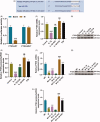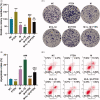Epigallocatechin-3- O-gallate promotes extracellular matrix and inhibits inflammation in IL-1β stimulated chondrocytes by the PTEN/miRNA-29b pathway
- PMID: 35260041
- PMCID: PMC8920401
- DOI: 10.1080/13880209.2022.2039722
Epigallocatechin-3- O-gallate promotes extracellular matrix and inhibits inflammation in IL-1β stimulated chondrocytes by the PTEN/miRNA-29b pathway
Abstract
Context: Epigallocatechin-3-O-gallate (EGCG) exhibits anti-arthritic activity. MiR-29b-3p provokes chondrocyte apoptosis and promotes the initiation and development of osteoarthritis (OA).
Objective: To explore the roles of EGCG and miR-29b-3p in interleukin-1β (IL-1β)-stimulated chondrocytes.
Materials and methods: HE and Safranin O staining were used to detect the pathological changes of cartilage tissue in OA patients and healthy people. OA-like chondrocyte injury was mimicked by 5 ng/mL IL-1β stimulation for 24 h in vitro, and after transfection with miR-29b-3p mimics and pcDNA-PTEN, IL-1β-stimulated chondrocytes were pre-treated with EGCG (20 and 50 μM) for 2 h. Cell viability, colony numbers, apoptosis rate, the levels of IL-6 and matrix metalloproteinase-13 (MMP-13), miR-19b-3p, PTEN and apoptosis-associated proteins in chondrocytes were evaluated.
Results: MiR-29b-3p level was upregulated in cartilage tissues of OA patients (3.5-fold change, p < 0.001) and IL-1β stimulated chondrocytes (two fold change, p < 0.001). The matrix staining was weakened and unevenly distributed, and the chondrocytes were arranged disorderly in the tissues of patients with OA. EGCG (20 and 50 μM) increases viability and decreases the levels of miR-29b-3p and MMP-13 and IL-6 in IL-1β stimulated chondrocytes (p < 0.05). MiR-29b-3p mimics reversed the effects above 50 μM EGCG (p < 0.05). Furthermore, PTEN overexpression abrogated the effects of miR-29b-3p mimics on viability, colony numbers, apoptosis rate and the levels of Bcl-2, MMP-13, IL-6, Bax and cleaved caspase 3 in IL-1β-stimulated chondrocytes (p < 0.01).
Discussion and conclusions: EGCG is a potential candidate for the treatment of OA, which also can be explored in a novel therapeutic method for other degenerative or inflammatory disorders.
Keywords: Epigallocatechin-3-O-gallate; miR-29b-3p; osteoarthritis (OA).
Conflict of interest statement
The authors declare no conflicts of interest.
Figures






Similar articles
-
Epigallocatechin-3-O-gallate up-regulates microRNA-199a-3p expression by down-regulating the expression of cyclooxygenase-2 in stimulated human osteoarthritis chondrocytes.J Cell Mol Med. 2016 Dec;20(12):2241-2248. doi: 10.1111/jcmm.12897. Epub 2016 Aug 12. J Cell Mol Med. 2016. PMID: 27515563 Free PMC article.
-
Baicalin Protects Human OA Chondrocytes Against IL-1β-Induced Apoptosis and ECM Degradation by Activating Autophagy via MiR-766-3p/AIFM1 Axis.Drug Des Devel Ther. 2020 Jul 7;14:2645-2655. doi: 10.2147/DDDT.S255823. eCollection 2020. Drug Des Devel Ther. 2020. PMID: 32753846 Free PMC article.
-
Epigallocatechin-3-O-gallate modulates global microRNA expression in interleukin-1β-stimulated human osteoarthritis chondrocytes: potential role of EGCG on negative co-regulation of microRNA-140-3p and ADAMTS5.Eur J Nutr. 2018 Apr;57(3):917-928. doi: 10.1007/s00394-016-1375-x. Epub 2017 Jan 21. Eur J Nutr. 2018. PMID: 28110479
-
Recent Therapeutic Strategies for Excessive Chondrocyte Death in Osteoarthritis: A Review.Orthop Surg. 2023 Jun;15(6):1437-1453. doi: 10.1111/os.13718. Epub 2023 Apr 18. Orthop Surg. 2023. PMID: 37073120 Free PMC article. Review.
-
miR-17-92 cluster in osteoarthritis: Regulatory roles and clinical utility.Front Genet. 2022 Nov 29;13:982008. doi: 10.3389/fgene.2022.982008. eCollection 2022. Front Genet. 2022. PMID: 36523768 Free PMC article. Review.
Cited by
-
Osteoarthritis in the Elderly Population: Preclinical Evidence of Nutrigenomic Activities of Flavonoids.Nutrients. 2023 Dec 28;16(1):112. doi: 10.3390/nu16010112. Nutrients. 2023. PMID: 38201942 Free PMC article.
-
Anti-Inflammatory Effects of Dietary Polyphenols through Inhibitory Activity against Metalloproteinases.Molecules. 2023 Jul 15;28(14):5426. doi: 10.3390/molecules28145426. Molecules. 2023. PMID: 37513300 Free PMC article. Review.
-
Polydeoxyribonucleotide ameliorates IL-1β-induced impairment of chondrogenic differentiation in human bone marrow-derived mesenchymal stem cells.Sci Rep. 2024 Oct 30;14(1):26076. doi: 10.1038/s41598-024-77264-2. Sci Rep. 2024. PMID: 39478005 Free PMC article.
-
Oroxin B alleviates osteoarthritis through anti-inflammation and inhibition of PI3K/AKT/mTOR signaling pathway and enhancement of autophagy.Front Endocrinol (Lausanne). 2022 Dec 1;13:1060721. doi: 10.3389/fendo.2022.1060721. eCollection 2022. Front Endocrinol (Lausanne). 2022. PMID: 36531454 Free PMC article.
-
Naturally derived injectable hydrogels with ROS-scavenging property to protect transplanted stem cell bioactivity for osteoarthritic cartilage repair.Front Bioeng Biotechnol. 2023 Jan 4;10:1109074. doi: 10.3389/fbioe.2022.1109074. eCollection 2022. Front Bioeng Biotechnol. 2023. PMID: 36686241 Free PMC article.
References
-
- Ahmed S, Rahman A, Hasnain A, Lalonde M, Goldberg VM, Haqqi TM.. 2002. Green tea polyphenol epigallocatechin-3-gallate inhibits the IL-1 beta-induced activity and expression of cyclooxygenase-2 and nitric oxide synthase-2 in human chondrocytes. Free Radic Biol Med. 33(8):1097–1105. - PubMed
-
- Ahmed S, Wang N, Lalonde M, Goldberg VM, Haqqi TM.. 2004. Green tea polyphenol epigallocatechin-3-gallate (EGCG) differentially inhibits interleukin-1 beta-induced expression of matrix metalloproteinase-1 and -13 in human chondrocytes. J Pharmacol Exp Ther. 308(2):767–773. - PubMed
-
- Bobinac D, Spanjol J, Zoricic S, Maric I.. 2003. Changes in articular cartilage and subchondral bone histomorphometry in osteoarthritic knee joints in humans. Bone. 32(3):284–290. - PubMed
MeSH terms
Substances
LinkOut - more resources
Full Text Sources
Medical
Research Materials
